Contents
Many gardeners are interested in the description, characteristics, photo of the Labella potato variety. And this is not accidental, since the culture is characterized by high productivity, keeping quality and excellent taste and culinary qualities. The Labella variety is grown not only for personal consumption, but also on an industrial scale throughout the Federation.

History of origin
The authors of the variety are breeders from Germany. The Solana company is known all over the world, because they specialize in creating hybrid varieties of different vegetable crops. In Our Country, the Labella potato was approved for cultivation in 2011, as it was included in the State Register. The variety was recommended for cultivation in some areas:
- Central;
- Central Black Earth;
- Volga-Vyatka;
- North Caucasian;
- Far East.
For several years, the geography of cultivation has expanded. Today, reddish-pink tubers enjoy can be found in almost all regions.
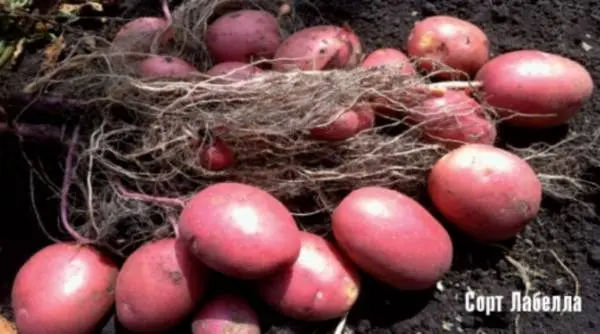
Description and characteristics
Variety Labella is distinguished by low, compact bushes with erect stems. The plant during the growing season does not scatter shoots. The leaves are saturated green, small, along the edges of the wave.
During flowering, the potato field turns purple with a barely noticeable pinkish tint. Flower corollas are neat.
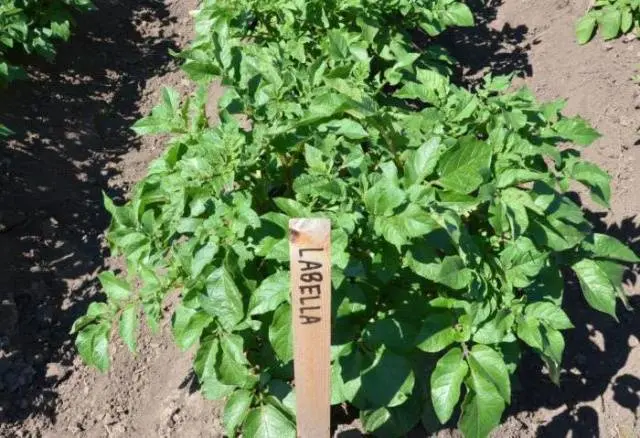
The root system is well developed, on a large number of stolons a rich harvest of 14-16 large even potatoes is formed. A trifle, although it occurs, but its amount is minimal.
Labella potatoes have elongated oval tubers weighing 78-102 g. Dark red eyes are located on the surface. Tubers with a smooth and thin skin of a pinkish-red color. The pulp is dense, light yellow, as in the photo.
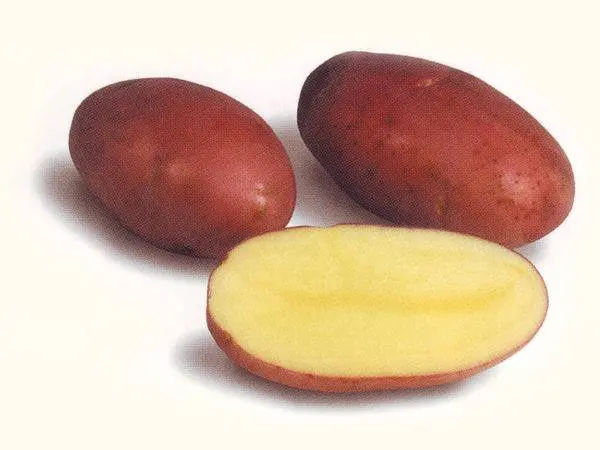
During cooking, Labella potatoes do not darken, do not lose their shape, so the use in cooking is the most diverse.
Advantages and disadvantages
Pros | Cons |
fruit evenness | Low frost resistance |
The variety is high-yielding, up to 300 kg of potatoes are harvested from one hundred square meters. |
|
Unpretentiousness of care |
|
Drought-resistant, short-term drought, the potato tolerates without much loss |
|
Excellent taste and culinary qualities |
|
High keeping quality, safety up to 98% |
|
Excellent transportability, preservation of presentation |
|
Disease resistance such as leafroll virus, golden potato nematode, blight, potato blight |
|
The variety contains up to 12% starch and a large amount of minerals, vitamins, salts |
|
Landing
Variety Labella is planted in fertile soil. Before planting, the tubers are germinated. It is taken out of storage a month before planting, so that the tubers warm up and give good strong shoots.
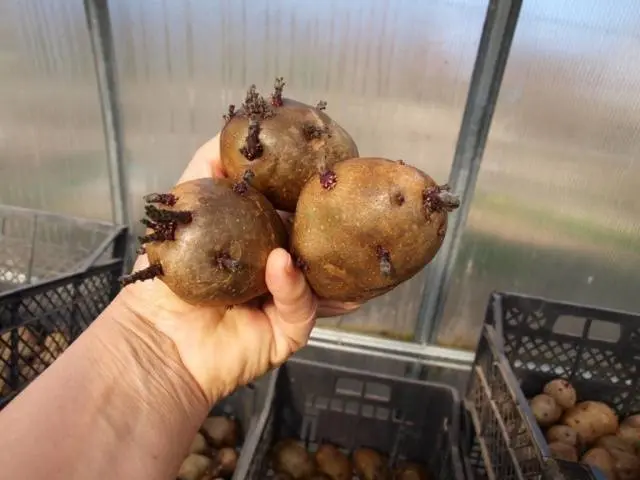
The Labella variety is planted in rows at a distance of about 70 cm, at least 30 cm between the holes. Potato tubers are laid out in the holes carefully so as not to break the bores. If the area is small, then when landing in the hole, they throw a handful of wood ash. Top the hole with earth.
Care
From the description and characteristics of the Labella potato variety, as well as from the reviews of gardeners, it is clear that the plant is unpretentious in its care. Even a novice gardener will cope with cultivation. Agrotechnical measures are reduced to:
- loosening and weeding;
- hilling and weeding;
- treatment of plantings from diseases and pests.
Loosening
After a few days, weeds will begin to appear on the potato plot. Don’t wait until they grow up. Labella potatoes are first nibbled, the grass, once on the surface of the site, dries up. Loosening will rid the site of weeds and saturate the soil and plants with oxygen.
Watering
According to the description, the Labella potato variety is drought-resistant, so watering is carried out only in drought. Under each bush poured from 12 to 15 liters of water.
Hilling and top dressing
Hilling is one of the important agrotechnical measures. The additional amount of soil contributes to the growth of underground shoots. In the scientific world they are called stolons. It is on them that tubers are formed.
The Labella potato variety is recommended to be spudded twice. The first time, when the shoots rise to a height of 15-20 cm. The second hilling is carried out in a week, until the potato tops have closed over the rows.
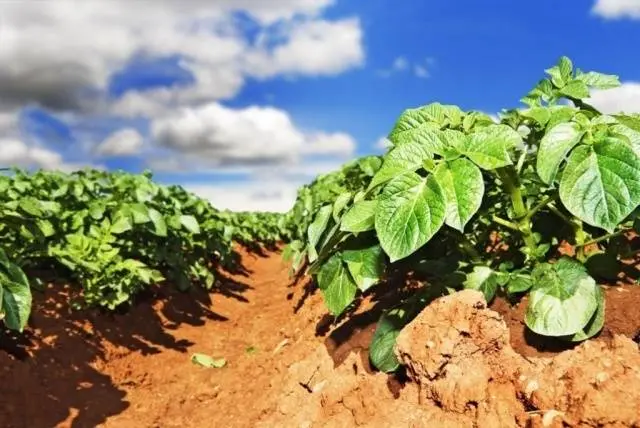
Potatoes need feeding:
- The first recharge is carried out at landing. In large areas, fertilizer cannot be added to each hole. Therefore, you can soak the potatoes before planting in a solution of urea (1 tablespoon of fertilizer per bucket of water).
- The second time the Labella potatoes are fertilized during the formation of buds. In 10 liters of water, dilute 1 tablespoon of potassium sulfate, 3 tablespoons of wood ash.
- When mass flowering begins, the potatoes are fed again so that tubers form faster. To feed the Labella variety, a solution of mullein, chicken manure or fermented grass is suitable.
Diseases and pests
The description says that the Labella potato variety is resistant to many diseases characteristic of this crop. But since several different varieties of potatoes are planted on the site, among them there may be those that have weak immunity. Therefore, preventive measures are required. At the first sign of disease, plantings are treated with herbicides. Herbicide-treated Labella potato bushes must be dug up before everyone else, and the tops should be burned.
If the variety has high resistance to many diseases, then pests will have to be fought. Young potato tubers can be damaged by the larvae of the click beetle (colloquially, the wireworm).
Wood ash helps from the wireworm, which is poured under each bush. It is desirable to pickle the seed. As for the Colorado potato beetle, the larvae will have to be collected by hand.
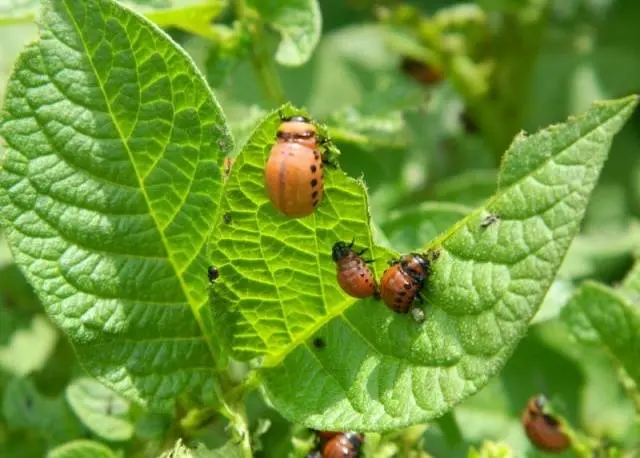
Harvesting
Dry sunny weather is chosen for harvesting. The bushes are dug up with a pitchfork or a shovel, then the tubers are selected. In each hole of the Labella variety, up to 16 large potatoes suitable for processing and storage are formed. Little things practically do not happen.
Harvest what you need, see for yourself:
The collected potatoes are dried for several hours in the sun, then removed for ripening in a dark, dry room for 10 days. The sorted and sorted tubers are lowered for storage in a cellar or basement. The crop is stored perfectly, by spring 98% of the crop is preserved.
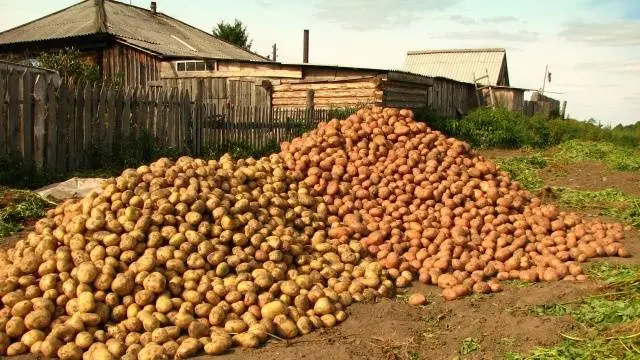
Conclusion
Gardeners who have been dealing with potatoes for more than one year call the Labella variety the best. After all, the plant is practically not affected by diseases and pests, unpretentious care. But most importantly – excellent taste and culinary qualities. In the reviews, gardeners indicate only positive points.









